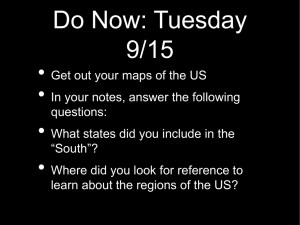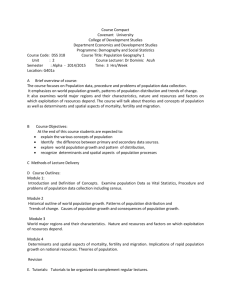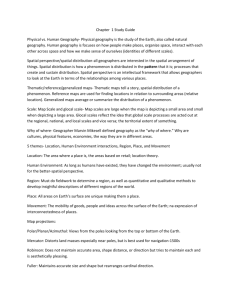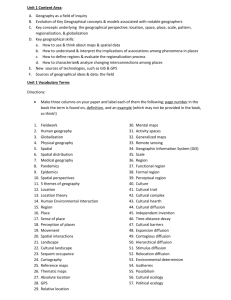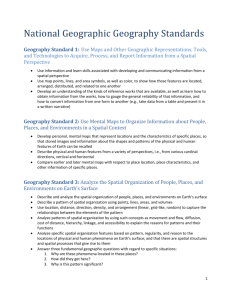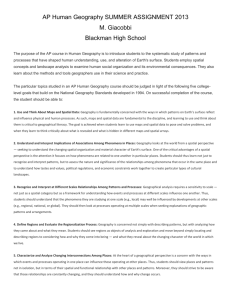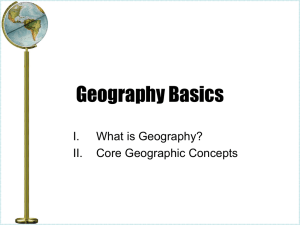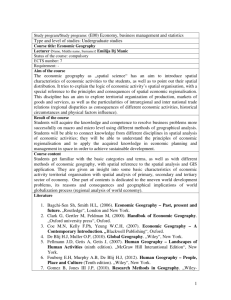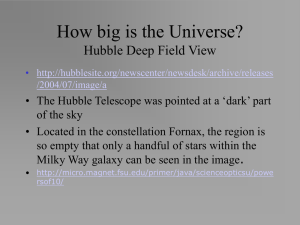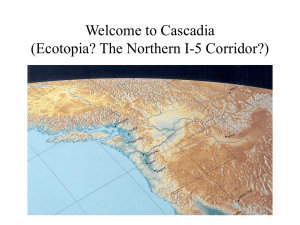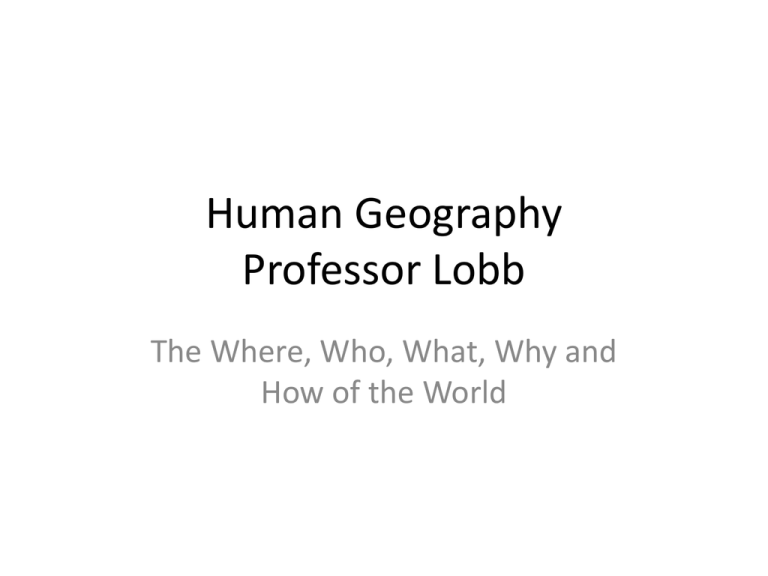
Human Geography
Professor Lobb
The Where, Who, What, Why and
How of the World
• What is Geography?
– Geography is the science of place and space.
Geographers ask where things are located on the
surface of the earth, why they are located where
they are, how places differ from one another, and
how people interact with the environment—AAG
– Geography is all about trying to make sense of the
world—Peirce Lewis
• Two Branches of Geography
– Physical: environmental dynamics
– Human: social dynamics
• What is Human Geography?
– Study of people, places, spatial variation in human
activities, relationship between humans and the
environment.
– Explaining the WHY of the WHERE
• Nature vs Culture?
– Nature: the physical environment, everything not
human
– Nature-Culture Dualism
• 18th C European Scholars: man superior to nature
• Impact on social rankings
• Cultural Ecology
– Humans relationship with the environment
• Environmental Determinism: nature
determines development of societies (and
individuals)
– Ancient Greeks—their climate perfect!
• Climate and location determined ‘success’ or
‘advancement’
– Early 20th C Geographers—Huntington, Semple
• The ‘unproductive’ Tropics
• The ideal mid-latitudes
• Criticism of Environmental Determinism
– Simplistic
– Ethnocentric
– Variability in adaptation
• New forms of Determinism?
– Political Ecology &
Actor-Network Theory
• Paul Robbins “Lawn People”
• Jared Diamond “Collapse,”
“Guns, Germs & Steel”
• Possibilism
– Human groups respond differently to the conditions
& constraints of the natural environment
• Humans as Modifiers of the Earth: Carl Sauer
– The Cultural Landscape
– Nature as a social construction: invented concept
derived from shared perceptions &
understandings
– People shape the environment through practices
and ideas about what nature is/should be
– Dynamic: William Cronon
• 18th C perceptions of wilderness vs. 19th C perceptions
• (wasteland vs beauty)
• The ‘success’ and ‘failure’ of human groups:
– A confluence of possibilities, social constructions
and modifications
– Sustainability?
• Easter Island
Hurricane Katrina, August 29, 2005, New Orleans, LA
Flooded neighborhood in New Orleans, 9 days after Hurricane Katrina. August-September, 2005.
Category 4 Hurricane
New Orleans, LA: 2/3 of the population was African-American, but area spared flooding was less
than ¼ African-American; % of rebuilding of destroyed homes has been much lower in
neighborhoods with larger African-American populations.
•
Netherlands: Sustainable Ecosystems?
• Organizing Space: Regions and Regional Analysis
– Formal
– Functional
– Perceptual (Vernacular)
Formal Regions: share a unifying characteristic
Educational attainment
Copyright © 2014 John Wiley &
Sons, Inc. All rights reserved.
Formal region: Blue States vs. Red States
Functional Regions: unified around an activity
Campus of the Univ. of Texas
U.S. television markets
Perceptual or Vernacular Region
The South
Chickasaw Country, Oklahoma
• Culture: what makes place unique
– “There’s no such thing as culture”—Don Mitchell
– Not fixed, dynamic
– Social creation
– Complex
– Material culture has to be understood in a larger,
dynamic context
• Reading the Cultural Landscape:
– What are the invisible dimensions of power, identity,
or class reflected in the cultural landscape?
• Defining Place
– Site and Situation
The site of Istanbul: on a hillside, next to a deep
harbor, on both sides of the Bosporus.
The situation of Istanbul, it’s relation to other nearby
bodies of water, the rest of Turkey, and even its
position in relation to neighboring regions.
• Does situation change over time?
• Can site be altered by humans?
Hurricane Sandy,
late October 2012
• Defining Space
– Absolute: an area that can be precisely measured
– Relative: space created by human activities,
interactions: trade relations, social networking
sites
– The Geographer’s spatial perspective: attention to
variations from one place or space to another in
society and environment-society dynamics
– Spatial variation, Spatial association
• Spatial Variation, Spatial Association and
Distribution
• Scale in Geographic Study
– Map or Cartographic Scale
– Observational or Methodological Scale
Map Scale:
Large vs Small Scale
Verbal Scale
Graphic Scale
Fractional Scale
• Observational or Methodological Scale
– Small scale: body
– Large scale: global
– The scale of the body: teeth filing, veiling
Video Explorations: Teeth Chiseling
At what point might cultural standards of beauty become a form of oppression?
Copyright © 2014 John Wiley & Sons, Inc.
All rights reserved.
• Maps: Representing Location
– Collecting data for maps
• Remote Sensing
• GPS
• GIS
Cell phones are equipped with GPS
The Power
of Maps
--Maps need
to be read
critically
--Who made the map?
To what end?
--the ‘problem’ with all
maps
• Thematic maps
– Display a ‘theme’ of information
(global rice production)
• Chloropleth
• Proportional Symbol
• Dot-density

